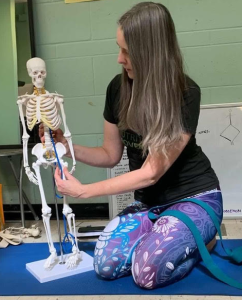Issue #308 – Wednesday, August 19, 2020
Position, Posture and Alignment
by Carol Robbins
Semantics is the branch of linguistics concerned with meaning. When we have a discussion with another person, it’s important that the words you use have a meaning that is agreed upon by both people or confusion can occur.
Have you ever had a conversation where you seem to go around in circles and are not able to pin down where the problem lies? I’ve found that not only do you have to be a good listener and start your sentences with “I’m hearing you say…” but when you define what it is you hear the other person say, you also outline what that thing means to you.
Teacher: “Raise your arms straight up. No, not like that – straight up!”
Student: “I’m hearing you say to raise my arms straight up. They are pointing to the sky, so what am I doing wrong?”
Now if that student is lying on their back, “straight up” might mean pointing to the ceiling to them, while to the teacher, it might mean over their head in line with their body. We would rarely cue a client to “flex your shoulder 180 degrees.” But the cue “raise your arms straight up” can result in confusion depending on the context.
The words “Posture,” “Alignment” and “Position” are often used interchangeably, but they have different meanings. It might be helpful to the movement community in general to have shared definitions of these words so when we use them, we can be sure of the semantics. In other words, Context Matters. In the previous example, the context is the person’s Position relative to the floor. If they had been standing up, the cue “raise your arms straight up could still be interpreted by the client as arms to the ceiling, but the resultant amount of shoulder flexion would be twice as much!
Let’s use a simple model to explore these terms: a bicycle. The Position of a bike’s front tire is determined by the handlebars. The tire can point straight (in line with the frame of the bicycle) or angled to the left (or right) enabling the bike to turn. A bike’s front tire is therefore Positioned for the direction the bicycle needs to go. Position is a static thing. Position can change all the time, but something had to move in order for the Position to change.
Alignment means something else. A bike’s tires are aligned when they are organised in such a way that whatever the bike’s job is will be optimised, with the most efficiency of the materials of both the tires and the parts that the tires rely on or affect. If the wheels are bent and wobbly, the tire can still point straight ahead (Position) but the Alignment will result in uneven wear and tear and the tire will have to be replaced sooner and more often. Have you ever tried to steer a bike with twisted handlebars? The relationship between the handlebars and the resultant Positioning of the tires is also Alignment.
So, a Position is a placement while Alignment is the relationship of the parts that Position entails and the parts around them. You turn the handlebars to adjust the Position of the tires to avoid that pothole in the street. If you don’t see it and the bike drives into the pothole, you might have to adjust your Alignment soon! Something might have become bent or otherwise misaligned. Even driving with the wrong air pressure in the tires can affect the Alignment. So, Alignment is not just about materials, relative positions and relationships, but also loads and forces such as pressure (air and the weight of a rider), gravity and acceleration.
Let’s broaden our model now from bike to human. A Position is just the starting placement of your various parts. Maybe the placement is “neutral” as in the directive “let’s start in neutral.” This is another term that may mean something to one person and something else entirely to another. For example, Neutral Pelvis implies a Position, but relative to what? What is the context? Is it relative to the femur, the lumbar spine or the ground? The Position of the pelvis might be Neutral in space, but not Neutral relative to the femur, so the Position is one thing, the Alignment another (and if you don’t know the difference you might be communicating ineffectively to the client and/or eliciting an unintended response from the exercise). In most cases, a person will need a reference point in order to understand a Position. But their Alignment is not something they can voluntarily adjust. You can change the positions of the body parts relative to each other to increase or decrease loads to the tissues in order to optimise Alignment. But creating “Alignment” with effort is simply creating an unsustainable Position.

The cue “drop your ribs” is one I use often. People pull their scapulae together and lift their chest to create what they believe is a desired Posture (we’ll get back to that word soon). This results in a ribcage that is tilted posteriorly (Position), and scapulae that are no longer sitting flat on the ribcage but rather are retracted (Position). This may result in several outcomes including: puts the rhomboids at a disadvantage to stabilise the thoracic spine, increases the resting length of the abdominal wall, shears T12 on L1, and changes the gravitational loads to the thoracic vertebrae. These are all examples of Alignment. A posteriorly tilted ribcage will also affect the Alignment of the cervical vertebrae and the Position of the head. The head can be in a forward Position, but the Alignment of the head/neck (and the resultant loads to those tissues) is the result of this Position. A person can be cued to “drop the ribs” but they might force them down using abdominal contraction, creating an unsustainable Position. Alignment occurs when the ribs are down because the various parts involved are at the appropriate resting lengths to allow it.
Posture is a culturally defined Position that is subjective. Cultural trends can be driven by celebrity, media, taste, function etc. We know what we want to see, and we try to Position our clients to most resemble it. If a person is unable to maintain this posture, they are said to be weak or have poor Posture. But we are subjecting them to a cultural ideal that can change and might not be the best Alignment for them.
Position can be any starting placement and is usually not subject to cultural trend. Posture is a culturally approved carriage that is usually assessed statically. Alignment is the objective measurement of parts relative to one another and the environment.

She blogs at alignmentrescue.com and can be found on Vimeo, Facebook and Instagram.

